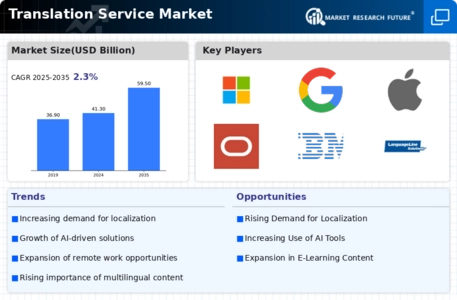Top Industry Leaders in the Translation Service Market

Competitive Landscape of Translation Services Market:
The translation service market, valued at over 47.21 billion in 2030, thrives on a globalized world where linguistic barriers can impede business expansion and cultural exchange. This vibrant ecosystem boasts a diverse range of players, from established giants to nimble start-ups, all vying for a slice of the pie. Understanding the competitive landscape is crucial for navigating this labyrinthine market.
Key Players:
- Language Line Solutions (U.S.)
- Lionbridge (U.S.)
- TransPerfect (U.S.)
- SDL (UK)
- GlobaLexicon (UK)
- Global Language Solutions, Inc
- Ingco International (U.S.)
- Straker Translations (U.S.)
- Mars Translation Services (China)
- Gengo (U.S.)
Strategies Adopted by Key Players:
- Established Giants: Leading the pack are established players like TransPerfect, Lionbridge, SDL, and RWS. These giants leverage their global reach, extensive language expertise, and comprehensive service portfolios to cater to large corporations and government agencies. Their strategies often focus on acquisitions, partnerships with technology providers, and R&D investments in AI-powered translation tools.
- Regional Powerhouses: Companies like Welocalize and Yamagata Corporation dominate specific regions, capitalizing on deep cultural understanding and localized expertise. They cater to regional businesses and offer specialized services like localization for specific industries or cultural contexts.
- Technology-Driven Newcomers: New entrants like Lingotek and Memsource are disrupting the market with their tech-first approach. They utilize machine translation (MT) engines, automation platforms, and cloud-based solutions to offer cost-effective and scalable services, particularly appealing to smaller businesses and individuals.
- Freelancer Networks: Platforms like ProZ and Upwork connect freelance translators directly with clients, offering flexibility and competitive pricing. While quality control can be a concern, these platforms are gaining traction for short-term projects and niche language pairs.
Market Share Analysis: The Crucial Factors:
Understanding market share dynamics in this fragmented landscape requires considering several factors:
- Service Portfolio: The breadth and depth of services offered play a significant role. Comprehensive players with technical translation, interpreting, and localization expertise hold an edge.
- Technology Adoption: Integrating cutting-edge MT engines and automation tools into workflows enhances efficiency and scalability, attracting tech-savvy clients.
- Language Expertise: Offering a vast array of languages and specialized domains like legal or medical translation expands clientele and commands premium pricing.
- Global Reach: A strong physical and digital presence across key markets allows for seamless service delivery and client engagement.
- Pricing Strategy: Balancing competitive pricing with service quality is crucial, with niche players offering cost-effective options and established firms commanding premium rates for high-touch services.
- Customer Service: Building strong client relationships and providing exceptional service fosters loyalty and repeat business.
New and Emerging Companies: The Next Wave
Several promising startups are poised to disrupt the market:
- AI-Powered Translation Engines: Companies like DeepL and Google Translate are pushing the boundaries of MT accuracy and fluency, making them attractive partners for translation service providers.
- Blockchain-Based Solutions: Startups like Trados and MultiLingual.com leverage blockchain technology to ensure data security and transparency in translation workflows.
- Vertical-Specific Platforms: Companies like Meditraduct and JurisLingua cater to specific industries with specialized translator networks and domain-specific knowledge bases.
Current Investment Trends: Where the Money Flows
Translation service providers are actively investing in:
- Machine Translation and AI: Enhancing MT engines and developing AI-powered post-editing tools to improve accuracy and efficiency.
- Cloud-Based Solutions: Migrating workflows to the cloud for scalability, accessibility, and improved collaboration.
- Localization Technologies: Developing tools for website, app, and content localization to cater to global audiences.
- Talent Acquisition and Training: Investing in attracting and retaining skilled translators and providing them with continuous training in new technologies and domains.
- Market Expansion: Expanding into new geographical markets and niche segments to diversify client base and revenue streams.
Latest Company Updates:
Samsung Electronics has revealed that its future Galaxy flagship model, which is scheduled to come early in 2023, would feature a real-time call translation service powered by AI. According to the business, this function will make multilingual conversation as simple as "turning on closed captions." When callers are conversing, the technology included into the new Galaxy model will enable seamless translation in text and audio forms.
Spotify introduced Voice Translation for podcasts in 2023. This innovative AI-powered function allows podcasts to be translated into other languages while maintaining the podcaster's voice.

